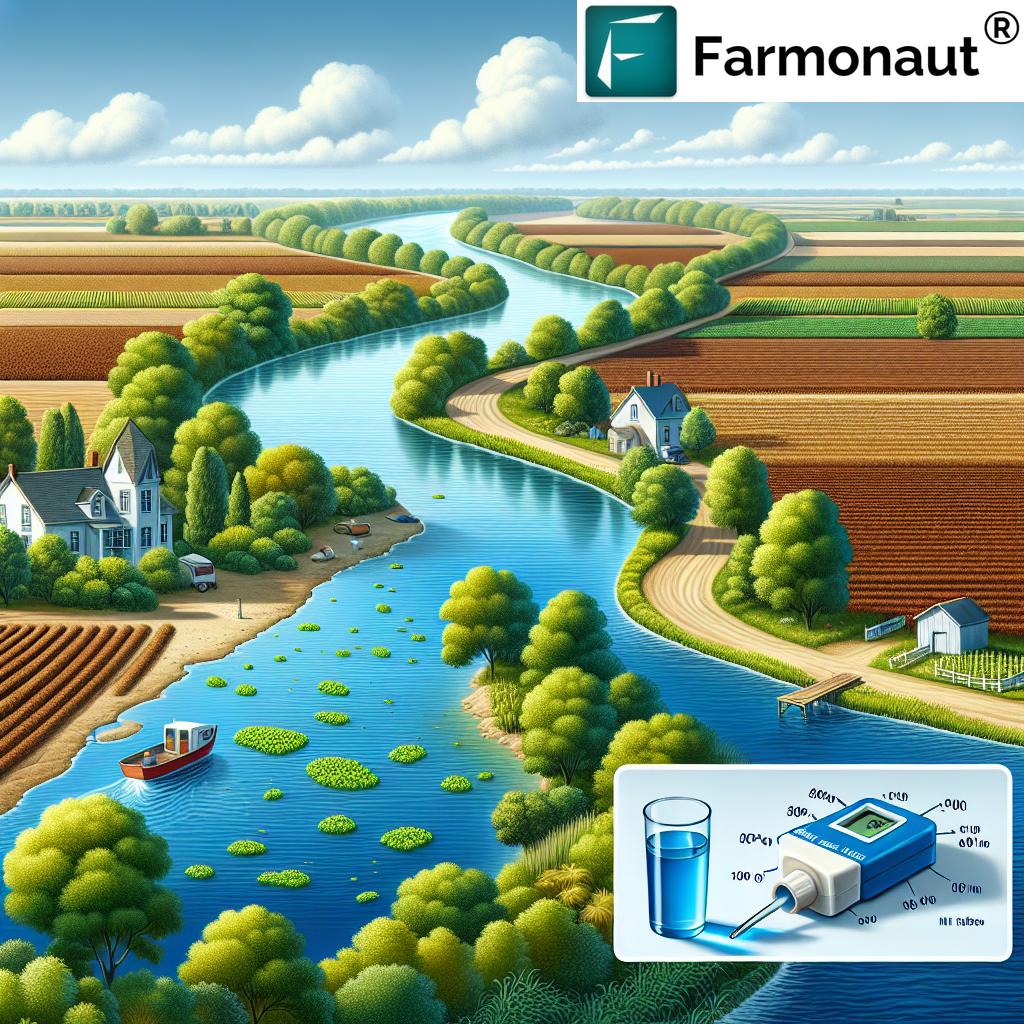Nitrate Levels: 5 Health Risks for Kankakee Infants
Introduction: Nitrate Levels and Kankakee River Water Safety
As Illinois residents focused on the health and safety of our families, we cannot ignore the recent nitrate levels in drinking water from the Kankakee River. The water situation in University Park, Peotone, and Kankakee has quickly escalated from concern to crisis, especially for infants under six months old. Following recent rainfall and spring agricultural fertilization, nitrate concentrations have surged, resulting in a drinking water alert from Aqua Illinois.
Health officials are warning families that nitrate levels in the Kankakee River exceed the Environmental Protection Agency’s (EPA) safe limit, putting infants at risk of blue baby syndrome—also known as methemoglobinemia. For many local families, especially those with young children, this situation demands knowledge, preparedness, and action.
In this comprehensive blog, we explore the origins of nitrate contamination, its health effects on infants, the current monitoring and alert systems in Illinois, and how we can protect our most vulnerable. Furthermore, we will discuss environmental sustainability, strategies for agricultural best practices, and how innovative solutions like Farmonaut are critical to the future of water safety.
What Are Nitrates? Understanding Health Risks
Nitrates are naturally occurring compounds made up of nitrogen and oxygen. Found in soil, water, some foods, and even inside the human body, nitrates play a vital role in plant nutrition. Yet, their presence in drinking water at high concentrations can be highly dangerous—especially for infants.
- Nitrates enter water sources via the spring agricultural fertilization process, agricultural runoff, and soil leaching.
- Our local river, the Kankakee, is especially susceptible due to intensive farming in the region.
- Ingesting water with elevated nitrate levels is hazardous for infants, pregnant women, and certain adults with existing health issues.
The EPA’s safe limit for nitrates in public water supplies is 10 milligrams per liter (mg/L) as nitrogen. Levels above this are strongly associated with adverse health outcomes, most notably blue baby syndrome or methemoglobinemia.
Farmonaut API enables agricultural researchers and institutions to utilize satellite data for real-time crop monitoring and helps optimize fertilizer use, which can reduce nitrate runoff into water bodies like the Kankakee River. See our API developer documentation to integrate environmental intelligence for your own water quality initiatives.
Blue Baby Syndrome Risk in Kankakee: A Local Crisis
The biggest and most immediate worry with high nitrate levels in drinking water is the heightened risk of blue baby syndrome (methemoglobinemia). When infants, especially those under six months of age, consume formula mixed with contaminated tap water, nitrates convert to nitrites in their gut. Nitrites then react with hemoglobin in their blood, creating methemoglobin, a molecule that cannot carry oxygen as efficiently as normal hemoglobin. As a result, oxygen transport in the blood is reduced, leading to potentially fatal consequences.
- Symptoms of blue baby syndrome include:
- Blue or ashen skin coloring, especially around the mouth and extremities
- Respiratory distress—rapid or difficult breathing
- Lethargy and irritability
- Seizures, coma, and, in extreme cases, death if untreated
According to the National Institutes of Health (NIH), early recognition and prompt medical intervention are critical for a good outcome.
Comparative Risk Table: Nitrate Levels vs. Health Risks for Infants (focus: Nitrate Levels in Drinking Water)
| Nitrate Level (mg/L) | EPA Safe Limit (mg/L) | Estimated Kankakee Level (mg/L) | Health Risk | Potential Impact on Infants |
|---|---|---|---|---|
| 0–5 | 10 | ~5 | Minimal/None | No significant risk |
| 5–10 | 10 | 8–10* | Elevated—Monitor | Possible mild effects, monitor infants closely |
| 10–15 | 10 | 12–14* | Above Safe Limit | High risk: methemoglobinemia, blue baby syndrome possible |
| 15–20 | 10 | 16+* | Serious Health Threat | Very high risk: severe oxygen deprivation, respiratory distress, hospitalization likely |
| 20+ | 10 | 20+* | Critical – Emergency | Immediate action required; life-threatening to infants |
*Estimated Kankakee River readings during nitrate surge events, based on public alerts.
Regular monitoring—especially during spring fertilization periods—using advanced satellite & AI-powered tools can help us detect and mitigate nitrate spikes, safeguarding our community.
5 Major Health Risks of Nitrate Exposure for Kankakee Infants
1. Methemoglobinemia in Infants (“Blue Baby Syndrome”)
Nitrate-contaminated water can quickly lead to methemoglobinemia. Infants exposed to such water are especially at risk because their gut bacteria more efficiently convert nitrates into toxic nitrites. These nitrites impair the blood’s ability to carry oxygen, causing discolored skin, irritability, and difficulty breathing, often resulting in hospitalization.
2. Impaired Oxygen Transport in Blood
Oxygen is essential to infant growth and neurological development. High nitrate levels in drinking water react with hemoglobin, reducing its ability to transport oxygen. Chronic exposure can cause delayed development, learning deficits, and increased susceptibility to infections due to under-oxygenation of tissues.
3. Respiratory Distress and Related Complications
Respiratory distress is often the first sign parents may notice in infants affected by nitrates. Labored breathing, persistent coughing, and even apnea episodes require immediate medical attention. If nitrate exposure continues, brain and organ development may be irreversibly affected by prolonged hypoxia.
4. Increased Risk of Seizures and Neurological Effects
Health effects of high nitrates are not limited to the blood. Seizures, irritability, persistent crying, or even coma can develop if infants are severely deprived of oxygen. The risk is compounded if medical intervention is delayed.
5. Potential for Long-Term Developmental Delays
Even after immediate threats are addressed, repeated or prolonged exposure to high nitrate water can result in developmental delays, impaired growth, and increased risks of certain pediatric illnesses. The links between nitrate ingestion and long-term childhood diseases remain an area of concern in Illinois’ public health community.
Why Are Nitrate Levels High? The Underlying Causes in Illinois
Just how did nitrate levels in the Kankakee River breach EPA safety thresholds? The main contributors are:
- Agricultural Runoff Water Pollution: Spring fertilization on vast tracts of farmland leads to nitrogen-rich fertilizers washing into the river after heavy rains. This process, called nutrient runoff, is the top source of nitrate water contamination in both Illinois and the Midwest.
- Soil Leaching: Naturally occurring nitrates can be leached deep into groundwater or surface water from the soil, especially when land is heavily tilled or fertilized.
- Well Water Vulnerability: While Aqua Illinois switched from wells to Kankakee River to provide a “cleaner” source, surface waters are actually much more at risk of rapid nitrate surges post-storm and during runoff events.
- Past Water Quality Crises: University Park and the surrounding areas recently faced a lengthy lead contamination event, eroding public trust in water safety and supplier assurances.
The combination of natural processes and human agricultural activity means that every spring, unless responsible practices are in place, the risk of nitrate contamination surges.
Protecting Kankakee Families: Practical Steps & Bottled Water Support
- Do NOT Use Tap Water for Infant Formula: Only use bottled or certified-safe water for preparing formula for babies under 6 months old. Even boiling contaminated water does not reduce nitrate concentration.
- Utilize Bottled Water for Infants: Aqua Illinois is distributing bottled water for affected families at designated locations. Take advantage of these services—they are critical for family safety until the alert is lifted.
- Consult Your Pediatrician: If your child has consumed tap water, contact your healthcare provider, especially if you notice changes in skin color, breathing, or behavior.
- Stay Updated on Alerts: Regularly check Aqua Illinois updates for the latest information regarding the water safety status.
- If Pregnant or Immunocompromised: Consult your doctor about your own water use. While infants face the highest risk, pregnant women and those with pre-existing conditions must exercise caution.
Leverage Technology for Safer Water — Farmonaut’s Impact
Proactive monitoring and smarter resource use are necessary to break the cycle of springtime nitrate pollution. By using Farmonaut’s platform, farmers and environmental managers can get real-time updates on crop health, soil moisture, and more.
- Carbon Footprinting: Monitor and reduce emissions resulting from fertilizer application and agricultural practices, helping mitigate the environmental factors that contribute to excessive nitrogen leaching into bodies like Kankakee River.
- Fleet Management Tools: Optimize agricultural logistics—improved timing and resource placement reduce unnecessary fertilizer runoff during rain events.
- Product Traceability: Blockchain solutions ensure transparency in agricultural supply chains, holding participants accountable for environmental stewardship and sustainable fertilization.
- Crop Plantation and Forest Advisory: Access satellite-driven AI crop advice to optimize nutrient management and safeguard soil/water quality.
Monitoring Water Quality in Illinois: The Need for Vigilance
Water safety is not a one-time fix. Ongoing vigilance is needed to protect families and maintain public trust. Monitoring water quality in Illinois is urgent in the Kankakee, University Park, and surrounding regions due to the cyclical nature of agricultural runoff and unpredictable weather.
- Use government and supplier alerts as your first line of defense but supplement with independent testing when possible.
- Farmers and water managers should leverage satellite imagery and AI-based tools from Farmonaut for near real-time analysis of environmental risk factors.
- Government agencies and NGOs should implement large-scale monitoring programs, using data-driven insights to anticipate and prevent nitrate spikes.
- Continual resource management, crop health analysis, and crop loan & insurance verification further strengthen community resilience against sudden contamination events.
- Timely communication among local officials, suppliers, and families is paramount—especially following weather events or changes in agricultural activity.
By integrating technology and responsible farming, we ensure a cleaner source of water for current and future generations.
The Role of Sustainable Agriculture and Farmonaut in Water Safety
Sustainability goes beyond immediate crisis response. To protect the Kankakee River and the health of our infants, we must adopt environment-friendly, data-backed agricultural strategies.
- Precision agriculture using Farmonaut: Real-time monitoring helps accurately apply fertilizers, minimizing runoff and improving nutrient uptake.
- Crop health insights: Advanced NDVI and soil moisture analytics ensure optimal crop growth with reduced environmental impact.
- Blockchain-based traceability: Guarantee that farm products are produced in a sustainable manner—offering peace of mind to environmentally conscious families.
- Resource management: Smarter logistics reduce the window for contamination events, mitigating the effects of sudden weather patterns or seasonal agricultural activities.
- Carbon footprinting: Monitoring farm-level emissions supports regulatory compliance and climate stewardship, positive for both local ecology and community health.
We recommend public agencies, farmers, and families collaborate—using platforms like Farmonaut to build real, resilient water protection for the people of Illinois. Our children and future generations depend on the actions we take today.
FAQ – Nitrate Levels & Infant Health in Kankakee
-
Q1: Why are nitrate levels suddenly higher in the Kankakee River?
Recent heavy rains combined with spring agricultural fertilization have caused more nitrates to be washed into the river. This is a common risk during spring seasons in agricultural regions like Illinois.
-
Q2: Is bottled water safe for mixing infant formula?
Yes, bottled water provided by Aqua Illinois comes from verified sources and is intended specifically to protect infants from nitrate-contaminated tap water.
-
Q3: How will I know when the water is safe again?
Aqua Illinois and local authorities will notify families as soon as nitrate levels return to a safe range. Stay tuned to official alerts before resuming tap water use for infants.
-
Q4: Are adults and older children at risk?
Healthy adults can usually tolerate low-level nitrate exposure, but pregnant women and individuals with compromised health may still face risks and should consult a medical professional.
-
Q5: How can I support prevention of future nitrate contamination events?
Support sustainable farming practices, promote precision agriculture, and advocate for advanced water quality monitoring systems in your community.
-
Q6: What technologies does Farmonaut offer for water and soil safety?
Farmonaut provides satellite-based crop monitoring, carbon footprinting, resource management, blockchain product traceability, and AI-powered advisory—all contributing to better nutrient management and environmental protection.
Conclusion: Building a Sustainable, Safe Future for Illinois Families
The nitrate crisis in the Kankakee River is a sober warning. As a community in University Park, Peotone, Kankakee, and neighboring Illinois regions, our commitment must be unwavering—protecting every child from the health effects of high nitrate exposure. From understanding the science behind blue baby syndrome risk to leveraging data-driven agricultural innovation, we can and must take action.
Let’s unite around sustainable practices, robust water quality monitoring, and open lines of communication. Technology providers such as Farmonaut equip us with powerful tools to address the root causes of nitrate contamination while fostering environmentally responsible growth.
- Avoid tap water for infants until alerts are lifted
- Use bottled water for formula and stay engaged with updates
- Advocate and adopt sustainable, precision agriculture
A safer, cleaner Kankakee River is possible—when informed families, responsive institutions, and innovative agriculture come together for the wellbeing of all Illinois residents.
Farmonaut Subscriptions: Affordable, Actionable Insights for Every Stakeholder
Unlock the full power of satellite-based precision agriculture, crop health monitoring, and water safety tools. Explore transparent pricing for farmers, agribusinesses, and institutions:
Stay alert. Act responsibly. Protect our youngest Illinois residents—today and for the generations to come.


















